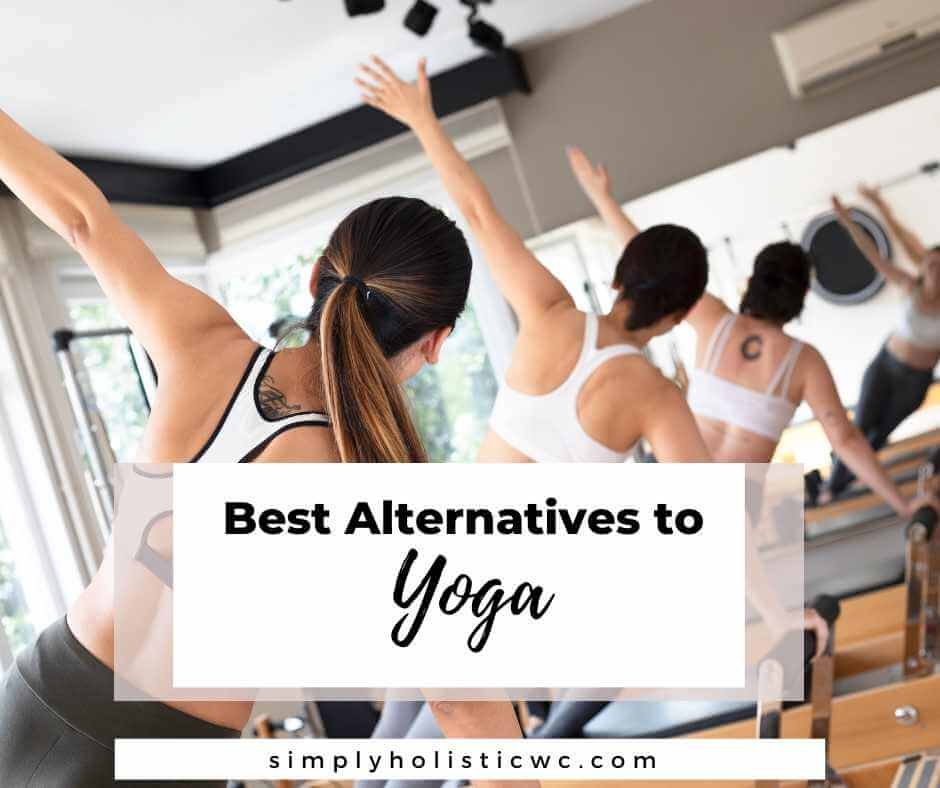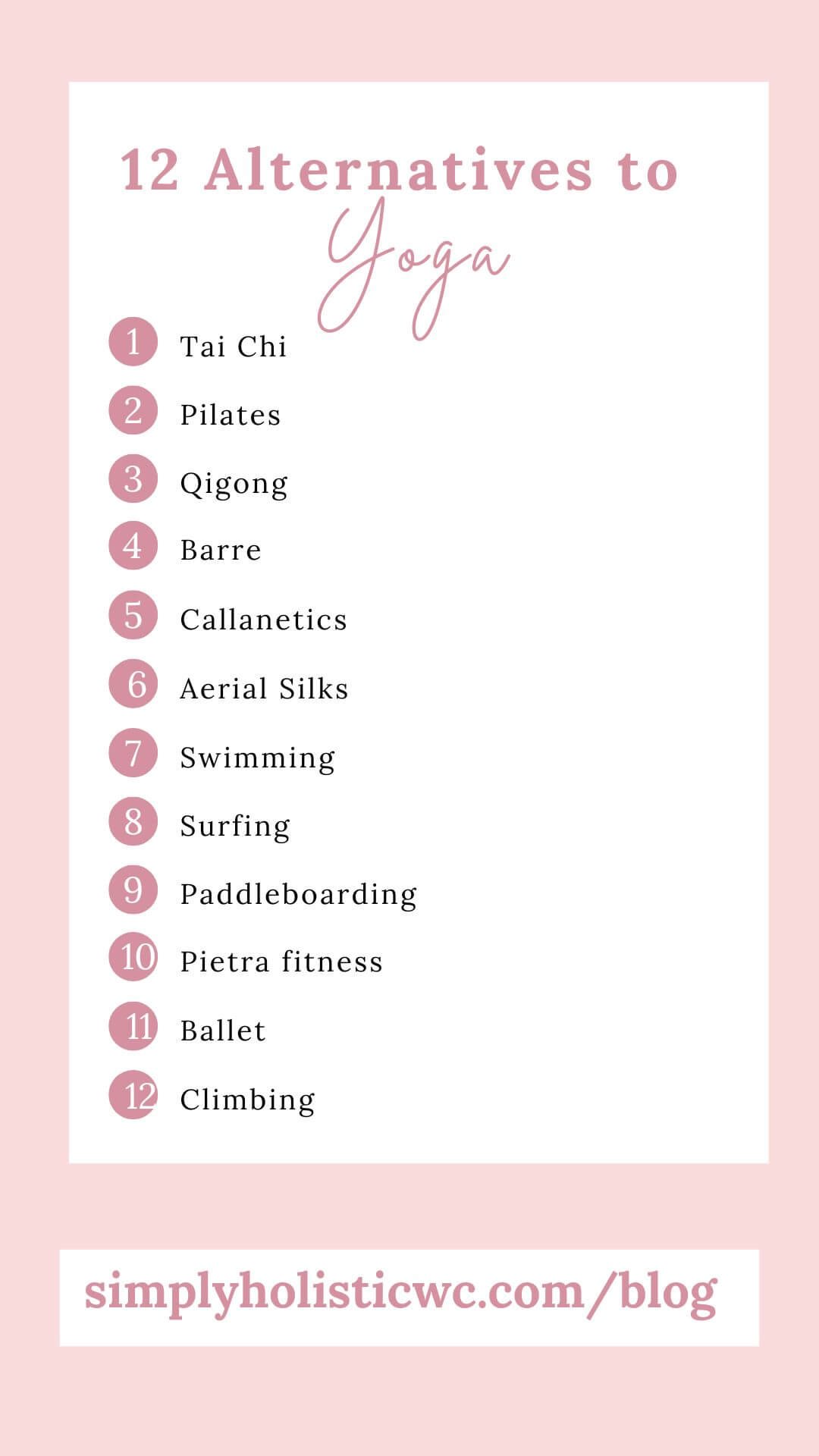12 Alternatives to Yoga
Are you looking for something new to switch up your yoga practice? Or you may want to find other ways to improve flexibility, strength, and mobility without having to do traditional yoga poses.
Whatever the reason, this blog post is all about exploring 12 alternative options to yoga!
Here you'll discover various activities that can provide the same physical and mental benefits of regular yoga practice.
Read on to explore these fun alternatives!
This post may contain affiliate links, for which I may receive a small commission at no cost to you. Please read our full disclosure policy.
What is Yoga?
Before we look at alternatives to yoga, it helps to know more about yoga and its benefits.
Yoga is an ancient practice that originated thousands of years ago in ancient India. It’s a holistic approach to physical and mental well-being and spiritual health. It focuses on the balance between body and mind.
There are different forms of yoga, including Hatha yoga, Ashtanga yoga, and Power yoga. If you have only tried one form of yoga and have not enjoyed it, you could try one of the many different styles of yoga.
Yoga consists of various postures, breathing techniques, and meditation practices. These help to improve strength, flexibility, balance, weight loss, and well-being.
The benefits of yoga include:
Increased muscle strength and tone
Improved posture and balance
Increased flexibility
Joint range of motion
Stress relief
Improved concentration
Better sleep quality
Yoga also has a positive effect on the nervous system.
Through mindful practice, yoga can help regulate the fight-or-flight response, reduce stress, and promote relaxation.
Studies have shown that regular yoga has helped people suffering from anxiety or depression by rebalancing hormone levels and reducing inflammation.
Beyond the mental effects of calming the nervous system, yoga practices can also help physical conditions. These conditions include high blood pressure and chronic pain.
Yoga is often seen as more than a physical practice, with some describing it as spiritual.
Many practitioners find yoga an excellent way to connect with the inner self. Some individuals use yoga to experience moments of stillness and contemplation.
For those who want to pursue yoga at a deeper level, there are traditions like Bhakti Yoga. These traditions involve chanting, mantras, and prayers from the Hindu tradition.
People practice yoga at home or in a formal yoga class held in a dedicated yoga studio.
In these classes, students are led by certified yoga teachers who can provide guidance and offer modifications for poses that might be too difficult for the individual.
Yoga teachers attend yoga schools and undergo hours of training. A yoga instructor is especially important, considering some poses can cause injury if not done correctly.
Yoga is an excellent way to improve physical and mental health. But it can be challenging to attend classes or get the guidance needed to practice it correctly.
Fortunately, there are some great alternatives that you can use to get the same benefits of yoga without having to go to a studio or even leave your home.
There's something for everyone! Plus, many of these options are affordable and easy to access.
So if you're looking for a way to enjoy all the benefits of yoga without practicing yoga, the alternatives in the post should be on your list!
Related:
25 Bible Verses for Stress and Anxiety
Why Some Individuals May Not Want to Practice Yoga
There are several reasons why someone may want to avoid practicing yoga.
These reasons include the following:
Cost
If you attend a studio or buy the items needed for at-home practice, yoga classes, equipment, and accessories can be expensive.
Difficulty
The poses and movements in yoga can be pretty challenging, especially for beginners.
Time Commitment
Taking regular yoga classes or setting aside a lot of time for daily practice is not always doable for everyone due to work or other commitments.
Accessibility
Some people may not feel comfortable attending an in-person class or may not have access to a suitable space for practicing yoga.
Health Concerns
An individual may have certain health conditions that make it unsafe or difficult to do some poses or movements involved in the practice.
Lower back, neck, and joint pain can be worse by specific postures and movements in yoga. So people should consult their doctor before beginning a practice.
Pregnant women are often advised to take extra caution when performing yoga.
It's essential for those who have specific health concerns to speak with their doctor about what activities are suitable for them.
Personal Preference
For some people, yoga may not be the right practice for them. Everyone is different and has preferences on what works best for them regarding physical and mental health.
If someone finds that yoga does not fit their lifestyle or interests, that's ok!
Instead of forcing yourself to practice something that doesn't feel enjoyable, try exploring different activities to find something that works for you.
Everyone has different needs when it comes to exercise routines.
Religious Beliefs
For some people, their religious beliefs may prevent them from practicing yoga.
The practice of yoga is associated with Hinduism and Buddhism. Certain religious groups may prohibit their members from doing any form of physical or spiritual exercise that isn't part of their established faith.
If you don't want to practice yoga because of the spiritual aspects, you can still cultivate yoga's physical and mental health benefits in other ways.
Related:
Don't miss out on our FREE habit tracker download, the perfect tool to help you start and stick to healthy habits.
Keep yourself motivated throughout your health journey with this simple and effective tracker.
Make your wellness goals a reality with just a click - download now and see the difference!
↓GET YOUR FREE DOWNLOAD↓
There are many alternatives to yoga when it comes to getting in shape and cultivating physical and mental well-being.
But, for those who can't or choose not to practice yoga for various reasons, it's important to remember that there are other ways to achieve similar benefits.
Before engaging in any physical activity or exercise program, consult your doctor first. This is especially important if you have any medical conditions.
Below are 12 alternatives to yoga that could help you reach your fitness goals.
1. Tai Chi
Tai chi is an ancient martial art in Chinese culture that focuses on relaxation and meditative movements.
It’s often described as a gentle exercise and can be a great alternative to yoga for those with health concerns.
While it does involve low-impact physical activities, the focus is on breathing and flowing through gentle movements.
Tai chi has many benefits, such as improving muscle strength, flexibility, and balance. It also reduces stress levels.
Also, it can increase energy levels and help you become more mindful of your entire body and movement.
2. Pilates
Pilates is a form of exercise that focuses on strengthening and toning the body while improving core stability, cardiovascular endurance, and posture.
Joseph Pilates is credited with inventing this exercise. Pilates could be a good option for those who don't enjoy traditional exercise or are looking for something more low-impact.
It encourages mindful movement. It also helps you become more aware and in tune with your body as you move through various exercises and breathing techniques.
The movements also help to strengthen both your physical and mental well-being. This makes Pilates an ideal alternative to yoga exercises.
A Total Gym allows you to do Pilates as well as stretching and cardio! This is a great machine for all fitness levels!
You can also use other things, such as a Pilates ball, Pilates bar, or Pilates ring, for a more effective workout!
Related:
3. Qigong
Qigong (pronounced chi-gong) is an ancient Chinese health practice that combines physical and mental elements to focus on relaxation. It also focuses on better circulation and overall well-being.
It’s a gentle exercise consisting of slow and mindful movements and deep breathing that helps clear the mind and relax the body.
Qigong focuses on cultivating qi (chi, life energy) which can help improve physical and mental health.
It can be a great alternative to yoga for those who want to experience the benefits of exercise without putting too much strain on their bodies.
This makes it ideal for those with health concerns.
4. Barre
Barre is a low-impact exercise that combines postures inspired by ballet, yoga, and Pilates.
It combines small, steady bursts of movement with stretching periods to help improve strength and flexibility.
Barre can be a great alternative to yoga for those who want to experience the benefits of exercise but don't enjoy traditional forms of workouts. It's also suitable for those looking for something more low-impact.
It encourages mindful movement. This helps you become more aware and in tune with your body as you move through various exercises designed to target specific muscle groups.
The movements also help to strengthen both your physical and mental well-being, making Barre an ideal alternative to yoga.
This portable Barre is great because it is foldable, so you can easily store it away when not in use. This portable Barre is a great way to bring the benefits of Barre anywhere you go.
5. Callanetics
Callanetics is a unique form of exercise developed by fitness expert Callan Pinckney in the 1980s.
It’s an effective low-impact workout that combines Pilates and yoga with ballet-style movements. This helps strengthen muscles, improve posture, and increase flexibility.
The exercises focus on slow and controlled movements. This helps promote proper alignment and technique while targeting various muscle groups.
Callanetics can be a great alternative to yoga for those who want to experience the benefits of exercise without putting too much strain on their body. This makes it ideal for those with health concerns.
It can also benefit people of all ages since it can be adapted to different fitness levels and provides an enjoyable way to stay active.
↓ PIN IT FOR LATER! ↓
6. Aerial Silks
Aerial Silks is an aerial acrobatic art that utilizes fabric to create a unique and challenging workout.
It combines elements of yoga, Pilates, dance, and gymnastics. It can help enhance physical strength, flexibility, balance, and coordination.
The exercises involve stretching and contorting oneself while suspended in the air. This gives you a full-body workout while also allowing you to be creative and express yourself.
Aerial Silks is a great alternative to yoga for those looking for something new, exciting, or challenging.
It provides an invigorating experience that helps strengthen the body. It also improves balance and flexibility without putting too much strain on the joints.
This set is easy to set up and includes everything you need to get started!
7. Swimming
Swimming is an excellent alternative to yoga for low-impact exercises that provide a full-body workout.
Swimming can help improve cardiovascular health, flexibility, and strength. It also provides a great way to relax and reduce stress levels.
Swimming is also ideal for people of all ages - from children to seniors - since it can be tailored to fit each individual's needs and physical abilities.
The lack of impact on the body makes it easier on the joints and muscles. This makes it a beneficial exercise for anyone with existing injuries or health concerns.
Swimming is a great way to stay cool during warm weather and can be enjoyed in any environment - from indoor pools to outdoor lakes and rivers.
8. Surfing
Surfing is an excellent alternative to yoga for those seeking an adrenaline-filled workout. It will leave you feeling energized and refreshed.
It provides an intense full-body workout that helps build strength, balance, coordination, and patience.
Surfing can help improve cardiovascular health. It can be done in the ocean, a lake, or a river, depending on where you live. It’s a great way to stay active and fit and a fun way to connect with nature and enjoy the outdoors.
It's also an excellent form of meditation as it teaches focus and mindfulness while gliding through the waves.
Grab a surfboard and head to the beach for a unique, fun way to stay fit!
9. Paddleboarding
Paddleboarding is an excellent alternative to yoga for those looking for an energizing workout while enjoying a beautiful outdoor setting.
It provides an intense, full-body workout that helps build strength and balance while also being low impact on the body.
Paddleboarding can help improve cardiovascular health, flexibility, and balance. And you can do it in both freshwater and saltwater settings.
It's ideal for people of all ages and physical abilities since you can tailor it to fit your needs.
It’s also a great way to stay cool during warm weather and can help reduce stress levels with its calming effects.
This all-in-one paddle board kit from SereneLife is a great way to get started!
10. Pietra fitness
Pietra fitness is an alternative to yoga for those seeking a full-body workout with meditative qualities. This workout combines strengthening and stretching exercises into a Christian-based workout.
It can help with reduced tension and stress. The workouts focus and deep breathing to help calm your mind. It also incorporates a spiritual element in that it includes prayer.
11. Ballet
Ballet is an excellent alternative to yoga for those seeking an intense full-body workout focusing on strength, flexibility, and coordination.
It's a low-impact exercise that can help improve your posture, balance, agility, and gracefulness.
Ballet combines the art of dance with the discipline of physical fitness, making it both enjoyable and physically rewarding.
Through proper technique and form, ballet can help develop strong core muscles. It can also help you develop strong legs and upper body strength.
Ballet helps increase joint mobility and improves flexibility. This can lead to better overall health.
All you need are the basics: comfortable clothing, ballet shoes, a barre, and a mirror.
With practice, you can hone your technique and become a graceful dancer!
Related: 13 Daily Habits to Improve Your Life
12. Climbing
Climbing is an excellent alternative to yoga for those seeking an intense yet therapeutic workout.
It focuses on developing physical, mental, and emotional strength. It also challenges both physical and mental capacity.
Climbing uses bodyweight exercises such as pull-ups, push-ups, and squats. These exercises build overall strength and endurance.
It focuses on balance, flexibility, and coordination. It can also help improve hand-eye coordination.
With its combination of cardiovascular exercise and strength and agility training, climbing provides a full-body workout with physical and mental benefits.
Conclusion
To wrap it up, there are various alternative forms of exercise to yoga, ranging from Tai chi to climbing.
These activities offer a unique way to stay fit while providing great physical and mental benefits.
Try different ones to find the one that works best for you and fits into your lifestyle. Don't be afraid to get out there and try something new - you might just discover a new passion or hobby that you love!
Unlock the power of healthy habits with our FREE habit tracker download.
This is the ultimate tool you need to start and keep track of your healthy habits.
With this resource in your toolkit, you'll be motivated to achieve your health goals and make your health journey much easier.
Download your FREE habit tracker now and start fueling your body with the nourishment it deserves!
↓GET YOUR FREE DOWNLOAD↓
References:



